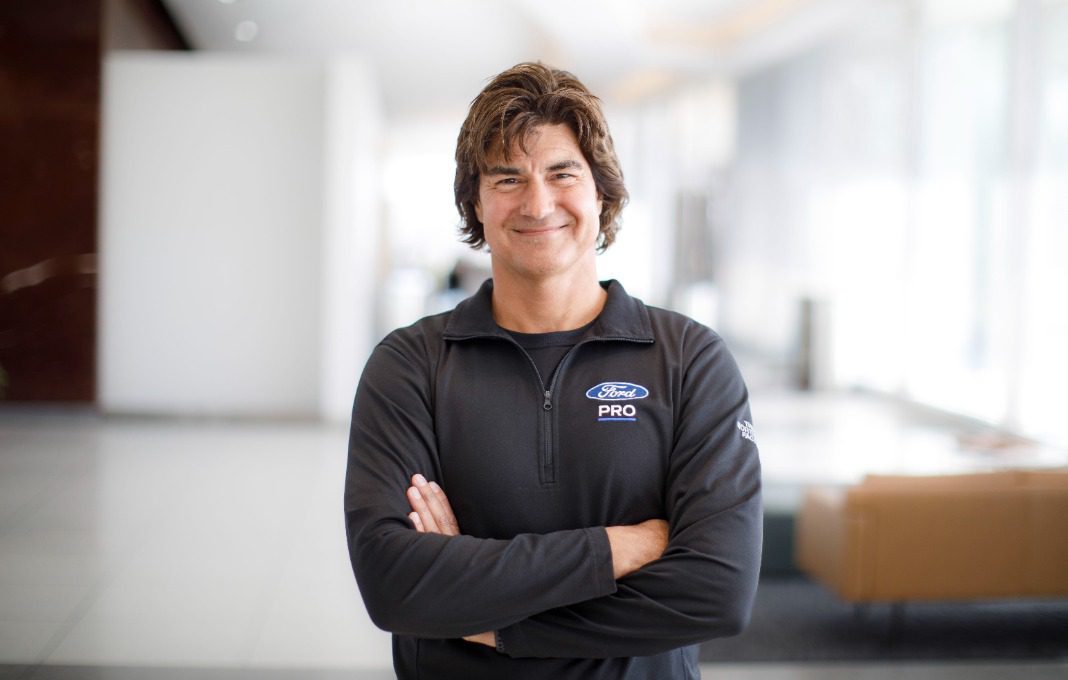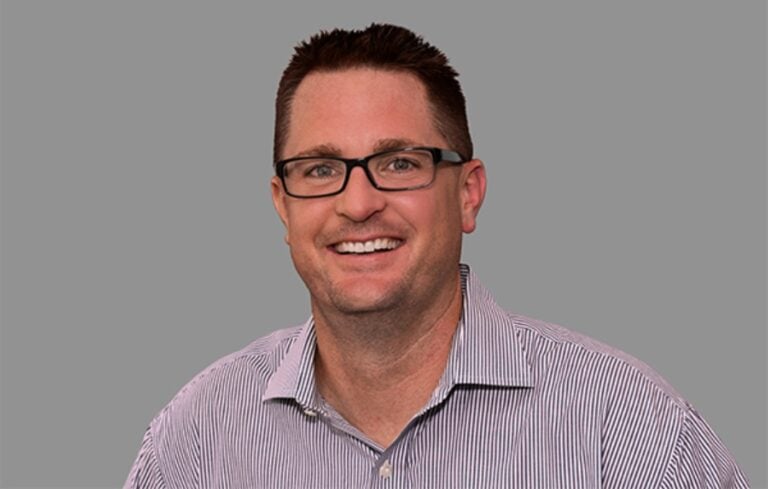


Like a Transit van hauling a work trailer, Ford Pro has become the vehicle that pulls Ford Motor Co. along, the commercial-vehicle sales and operations unit that has been the best-operating portion of an automaker whose other parts have been wheezing just a bit.
The nearly $60 billion business within Ford serves commercial customers with a one-stop shop of work-ready vehicles, service, software, charging and financing solutions that can make running a fleet simpler and more productive. Made up of Ford’s traditional fleet and commercial businesses as well as emerging telematic, logistics and other connective systems for business customers, Ford Pro takes an agnostic approach to the means of propulsion—gasoline, diesel, electric—for its B2B customers, while for consumers Ford now has a Model e division managing its high-stakes electric future and another, Blue, that is tending to its profitable traditional vehicle lineup.
Ford Pro has been posting fantastic numbers since its creation in 2021, befitting a shift in Ford’s B2B business model led by Ford CEO Jim Farley and abetted by Ford Pro CEO Ted Cannis. Sales rose by $18 billion in the first quarter, a year-to-year increase of 36 percent, while Ford Pro’s operating income rose by 81 percent in 2023 with a 12.4 percent operating margin. That bested even the 7.4 percent margin for Ford Blue.
“We knew there was this opportunity to create a bundled suite of services, a one-stop-shop for B2B customers, who only had fragmented solutions, around new services like software and charging,” Cannis tells Chief Executive. “We had just started connecting vehicles in 2019 with connected modems, and we were getting better data, and getting better at extracting that data for the benefit of the customer at their request. It created continuous relationships with customers that we didn’t have when the cars weren’t connected.”
Ford already held an outsized share of most commercial-vehicle markets with its Transit vans, F-Series trucks, Interceptor police SUVs and other lines, and now it has a 40 percent U.S. market share of Class 1 through 7 full-sized trucks and vans. Now Ford Pro’s telematics allows owners, for instance, to get an overall picture of their fleets, from maintenance reports to vehicle locations to fuel efficiency to repair needs to the behavior of drivers.
“We work with fleet managers whose jobs are on the line,” says Cannis, a 35-year company veteran who headed Ford’s earlier Team Edison operation for developing the electric-vehicle business.
Ford Pro has more than 500,000 software paid subscriptions, up 46 percent year over year, and those margins are more than 50 percent, the company says. Ford expects this area will drive 20 percent of Ford Pro operating income in two years.
While American consumers and businesspeople are still largely making up their minds about the future of their electric-vehicle purchases, two early features of this period of foment in automotive propulsion have favored Ford Pro.
Commercial fleets have been the fastest segment of the transportation economy to embrace electric power, for reasons including the fact that many of them can be charged overnight in a single location, and Ford Pro has been leading the way among rivals with EV models. After it launched the E-Transit in 2022, the cargo and utility van captured a 50 percent share of segment sales right away, Cannis says.
“In the U.S., we’ve got the Post Office business, 9,250 units this year,” he says. “We have sold 300 E-Transits [and more than 200 Mach-E SUVs] to New York City” for law-enforcement and emergency response to replace gas-powered vehicles. “We have a wide base of customers. And later this year, later than we wanted, we will introduce a longer-range version of E-Transit.”
Ecolab is proceeding from a 100-vehicle pilot to phase one of a national, 10,000-vehicle fleet electrification which involves 1,000 Ford Pro vehicles and 400 EV chargers. Elite Health Care went from one E-Transit in 2022 to 27 today based on its experience saving almost $6,500 a year per van on operating costs, Ford says. And so on.
Competitors have begun responding to the B2B opportunities they may have left to Ford Pro so far. GM announced GM Envolve, a “one-stop customer experience” across its brands, in 2023, and Stellantis launched a commercial strategy called Stellantis Pro One. But rivals, Cannis says, haven’t done as good a job as Ford Pro of integrating their service offerings.
Here are some ways Cannis has helped Ford Pro essentially create a new business model and stay ahead of the competition:
Try something new. Of all the departures that Farley has made within Ford since he took the helm nearly four years ago—launching crash EV programs, committing to build massive battery and EV plants, splitting operations, putting autonomous-vehicle programs on a side burner and more—creating For Pro might have been his best move.
“He brought to light in this company a look at a gem that we didn’t really know we had,” Cannis says. “I give him full credit.” By creating an entity in Ford Pro, Farley also “gave us a way to financially segment the P&L capabilities of the commercial operation,” Cannis says. “He wanted to create accountability to focus our enterprise around the commercial B2B customers and to provide them the products and services they need.”
Follow customers. Ford Pro commendably followed B2B customers to whichever forms of propulsion they preferred, because the big margins are in the service network, not vehicle sales.
“We’re doing both [electric and internal combustion engine, or ICE] solutions or it would be confusing for everyone,” Cannis says. “We are making one umbrella, one interface, one suite of services around the software-defined vehicle and Ford Plus connectivity. Makes it easy for the customer.”
Ford Pro also responds to customer input about what services to add or even discontinue. A new feature that freezes operation of vehicles between certain hours, thwarting theft, perfectly fit a need case brought to Ford Pro by a construction company in Colorado. “We launched it in January,” Cannis says.
Don’t expect too much. Electrification remains a huge learning curve for B2B automotive customers as well as consumers. “This transition is difficult,” Cannis says. “We’ll have ICE vehicles in fleets for a long time; [commercial owners] only flip about 10 percent to 15 percent of their fleets each year.
“One early customer said they will buy 2,000 [E-Transits], but in 2022, they bought only one. They had to do huge data transfers and conduct trials. Last year, they bought maybe 10, and this year it’ll be more like 100. They need to have time for the [EV-charging] infrastructure to get into the ground.”




0

1:00 - 5:00 pm
Over 70% of Executives Surveyed Agree: Many Strategic Planning Efforts Lack Systematic Approach Tips for Enhancing Your Strategic Planning Process
Executives expressed frustration with their current strategic planning process. Issues include:
Steve Rutan and Denise Harrison have put together an afternoon workshop that will provide the tools you need to address these concerns. They have worked with hundreds of executives to develop a systematic approach that will enable your team to make better decisions during strategic planning. Steve and Denise will walk you through exercises for prioritizing your lists and steps that will reset and reinvigorate your process. This will be a hands-on workshop that will enable you to think about your business as you use the tools that are being presented. If you are ready for a Strategic Planning tune-up, select this workshop in your registration form. The additional fee of $695 will be added to your total.

2:00 - 5:00 pm
Female leaders face the same issues all leaders do, but they often face additional challenges too. In this peer session, we will facilitate a discussion of best practices and how to overcome common barriers to help women leaders be more effective within and outside their organizations.
Limited space available.

10:30 - 5:00 pm
General’s Retreat at Hermitage Golf Course
Sponsored by UBS
General’s Retreat, built in 1986 with architect Gary Roger Baird, has been voted the “Best Golf Course in Nashville” and is a “must play” when visiting the Nashville, Tennessee area. With the beautiful setting along the Cumberland River, golfers of all capabilities will thoroughly enjoy the golf, scenery and hospitality.
The golf outing fee includes transportation to and from the hotel, greens/cart fees, use of practice facilities, and boxed lunch. The bus will leave the hotel at 10:30 am for a noon shotgun start and return to the hotel after the cocktail reception following the completion of the round.